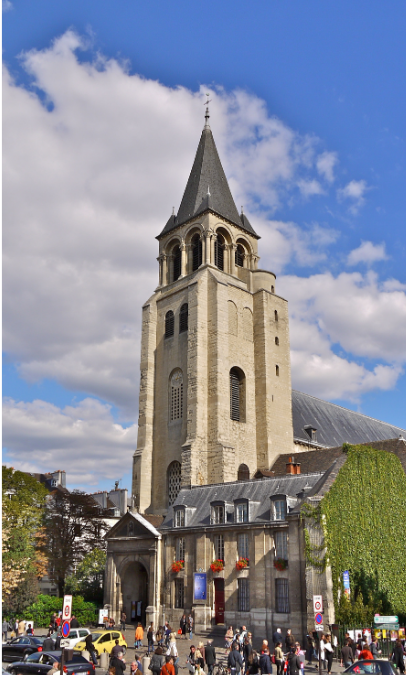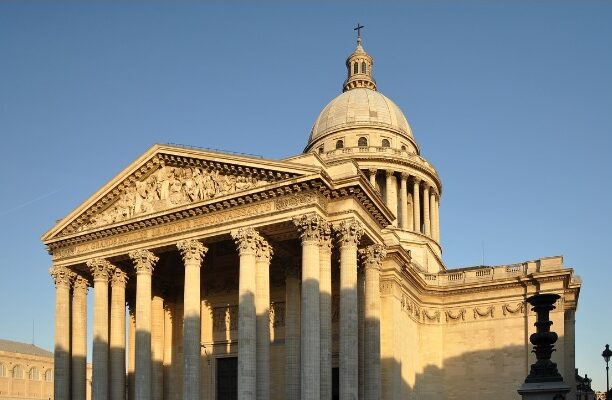
By Judy Carmack Bross
Curator extraordinaire Russell Kelley, who has lectured for the Alliance Française de Chicago on the great chateaux and gardens of France, returns January 12 for a six-part zoom series on the most beautiful churches of Paris.

Russell Kelley
 Notre Dame
Notre Dame
Kelley, whose own Paris apartment overlooks Notre Dame, spent the summer researching his lectures on how the churches were built and often re-built and their historical context. Not only will he share the most recent photos and news of Notre Dame’s reconstruction, he will visually transport guests to Saint-Germain-de Prés, Sainte Chapelle, Les Invalides, The Pantheon, and Sacré Coeur in separate lectures every Thursday at noon from January 12 through February 16.
 Saint-Germain-de Pres
Saint-Germain-de Pres

Mary Ellen Connellan
Mary Ellen Connellan, Executive Director, Alliance Française de Chicago, told us how the idea of the series evolved:
“Ever since one of our devoted board members introduced us to the charismatic, entertaining, and scholarly Russell Kelley, who is involved with the Alliance Française of Metro Miami, we’ve been having a splendid time following him on visits to the grandest of Grands Châteaux, the most exquisite of jardins, and now… Russell returns with what he calls “the history of ecclesiastical architecture in France” but what I prefer to call a tour of the most beautiful churches of Paris! My personal favorite is Saint-Germain-des-Prés, in the sixième arrondissement. As luck would have it, I attended the wedding of a dear friend there early this fall and experienced the magic of its majesty firsthand. Breathtaking!”
 Sacre Coeur
Sacre Coeur
We spoke with Kelley in Miami just before he left for Christmas in Paris with his family. “Over my entire lifetime I have wandered with a guidebook into these churches, but recently I sat down and really studied their history and design and came away with a greater appreciation for the remarkable architecture and engineering skills. I don’t view these individual churches in isolation but as part of a continuum set in historical context for example, what led to the Gothic or the Romanesque style?”
Kelley told us more about how he will present his lectures:
“The Church Series will trace the evolution of church-building in Paris, starting with the rustic Romanesque abbey churches that rapidly spread across France during the 11th and 12th centuries, followed by the soaring Gothic cathedrals built using new engineering techniques between the 12th and 15th centuries, then the Italian-inspired Renaissance churches of the 16th century and the domed Baroque churches of the Counter-Reformation of the 17th century, and the Neoclassical churches with their distinctive columns constructed before and after the Revolution. The series will also cover the 19th century movement to restore the venerable edifices that had fallen into ruin through neglect or depredation, and the concomitant construction of eclectic churches using new building materials and techniques. The series will conclude with the long and eventful tale of the greatest Parisian church of all: Notre-Dame de Paris. When it was built in 1163, there had already been three earlier churches on that spot.
“As with previous series, the lectures will start by setting the stage for each period, describing the historical context in which the great churches of Paris, all Roman Catholic, were built and rebuilt, often several times, as the Church evolved from its position as the dominant institution of the Middle Ages to a rival for power with the kings of France, from its vigorous response to the Reformation to its suppression during the Revolution and rebirth in a lay society with many religions in the 19th century, with the formal separation of Church and State in the 20th century.”

Sainte Chapelle
Aimee Laberge, Director of Programs for the Alliance Franciase de Chicago, told us:
“Working with Russell has brought us our biggest success in terms of online programs and global attendance and it’s been a unique learning experience for our team from the start. Not only do we get to listen to every words Russell and his guests say during their presentation, but we also get to “hang out” behind the scene during the technical rehearsals with the likes of Henri Menier, whose family has owned the Chateau de Chenonceau for five generations; storyteller extraordinaire and former mountain guide Alexandre De Vogüe, owner with his brothers of Vaux-le-Vicomte; or Alix de Saint-Venant, the passionate gardener and owner of Château de Valmer. Beyond making sure that everything runs without a glitch, not a foolproof process believe me, this is what makes our job so darn interesting! We are also thrilled to work again in tandem with the Alliance Francaise de Miami Métro, a very young and dynamic Alliance led by Patricia Bona and Stanislas Riener, on Russell’s new series, The Great Churches of Paris.”
Teaching architectural terms is key to Kelley: “It’s important to have the vocabulary: what is a barrel vault ceiling, a triforium gallery, a clerestory window? As you wander through a church reading about these characteristics, how can you appreciate them if you don’t know what they are?”
Kelley wants to equip participants to be able to go into a church of any period and be able to identify key structural elements. “Knowing what the style is characterized in the church, what do you learn by looking at the ceiling, how high the windows are, what kind of choir: the experience will be much more enriching.”
 Les Invalides
Les Invalides
His lectures will show the extraordinary variety of churches built in every commune of France, but especially in Paris, over the last 1000 years beginning with Saint-Germain-des-Prés on January 12.

The Pantheon
“The first churches were built in Paris in the 6th century, but they were all destroyed during the Viking invasions of the 9th century. After the Viking threat was removed, monasteries rapidly spread across France in the 11th and 12th centuries, and they surrounded Paris,” Kelley said. “The oldest churches in Paris, all originally associated with monasteries, date from this period and were built in the Romanesque style.”
We asked Kelley for a reconstruction update on what has been fondly termed as “everyone’s church” following the tragic Notre-Dame fire April 15, 2019.
 Notre Dame
Notre Dame
“The stated objective is for Notre Dame to be opened to the public and for services before the Paris Summer Olympics scheduled for July 2024. They are currently repairing the vaulted ceiling that was punctured by falling debris when the steeple burned. Over 1200 oak trees from every corner of France, some trees over 200 years old, are being felled to authentically replace those that burned in the roof’s attic. They will be restoring the interior this year.”
You may register for the series of 6 lectures if you are a member of the Alliance Française de Chicago. Individual lectures are for members and non-members. The Alliance “Entrée Libre” initiative offers free admission to students and professors registering with their .edu email address.
Visit af-chicago.org to learn more.







